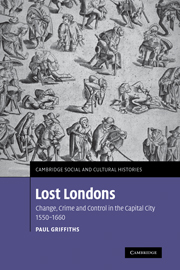Book contents
- Frontmatter
- Contents
- Maps and tables
- Abbreviations
- Preface
- Introduction: Rhetorics and records
- Part I Change
- Part II Crime
- Part III Control
- 6 Court days
- 7 Bodies
- 8 Policing: people and policy
- 9 Policing: night battles
- 10 Policing: process and prosecution
- 11 Policing: knowledge
- Conclusion
- Appendix
- Bibliography
- Index
9 - Policing: night battles
Published online by Cambridge University Press: 15 December 2009
- Frontmatter
- Contents
- Maps and tables
- Abbreviations
- Preface
- Introduction: Rhetorics and records
- Part I Change
- Part II Crime
- Part III Control
- 6 Court days
- 7 Bodies
- 8 Policing: people and policy
- 9 Policing: night battles
- 10 Policing: process and prosecution
- 11 Policing: knowledge
- Conclusion
- Appendix
- Bibliography
- Index
Summary
‘Terrors of the night’
‘The terrors of the night’, Thomas Nashe said chillingly, ‘are as many as our sinnes’, and the ‘sinnes of the night surmount the sinnes of the day’. Nashe was thinking of ghosts, hair-raising dreams, creaking doors and floors, and fire and crime in the pitch black dark. ‘My house is mighty dangerous, having so many ways to come in’, Pepys mused, after a friend had told him that he and his wife trembled in bed ‘night after night’, hearing ‘noises over their heads upon the leads’, thinking panic-stricken thoughts about thieves creeping over roofs, looking for windows left carelessly open. Pepys tossed and turned in bed all night long, ‘thinking every running of a mouse really a thief’. Simply seeing someone leaving a dark house through a back door made pulses beat faster.
More care was needed in night's ‘dead time’ as danger always lurked somewhere in the shadows. Night-time was more dangerous, people were more on edge and more sensitive to the slightest tap or rattle in night's quiet. Law-abiding Londoners liked to be locked in their houses in an envelope of security as they slept in bed, leaving nothing to chance. Anne Owen made the careless mistake of leaving ‘her masters door wyde open’ at midnight, and she found herself in court within a week.
- Type
- Chapter
- Information
- Lost LondonsChange, Crime, and Control in the Capital City, 1550–1660, pp. 332 - 360Publisher: Cambridge University PressPrint publication year: 2008



